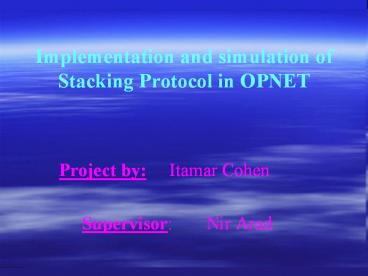Implementation and simulation of Stacking Protocol in OPNET - PowerPoint PPT Presentation
1 / 12
Title:
Implementation and simulation of Stacking Protocol in OPNET
Description:
Prestera is novel high-performance chipset architecture by MARVELL. Prestera Stacking Protocol (SP) is used to configure several switching devices ... – PowerPoint PPT presentation
Number of Views:285
Avg rating:3.0/5.0
Title: Implementation and simulation of Stacking Protocol in OPNET
1
Implementation and simulation of Stacking
Protocol in OPNET
- Project by Itamar Cohen
- Supervisor Nir Arad
2
Project General Description
- Prestera is novel high-performance chipset
architecture by MARVELL. - Prestera Stacking Protocol (SP) is used to
configure several switching devices as a single
network entity. - SP operates on top of two transport protocols,
named RMF and FMF. - In this project RMF and FMF will be implemented
and tested in the OPNET Modeler.
3
RMF (Reliable Message Forwarding) protocol
- Responsible for hop-to-hop communications between
switching devices. - based on Stop Wait algorithm.
- Handles SAR (segmentation and reassembly) of
packets. - Has interfaces to the sending application and to
the hardware driver, which receives the packets
from the stream.
4
S W demonstration
5
S W demonstration (Cont)
6
(No Transcript)
7
(No Transcript)
8
RMF implementation issues
- A single RMF process serves a few application and
uses a few links. - Each link has its own parameters
- Number of retries
- I.D. of the requested cell (0 or 1).
- Identity of the destination application.
- Each link and each application has its own SAR
buffer. - Time out counting is executed by scheduling
future events, and canceling them if the ACK has
already arrived.
9
FMF (Flood Message Forwarding) protocol
- Built above the RMF.
- Based on the PI (Propagation of Information) and
PIF (Propagation of Information with Feedback)
algorithms. - Handles the whole-network requirements.
10
PI - definitions
- MSG (info) a message carrying the information
info to be propagated. - Gi - set of neighbors of node i.
- mi indicates whether node i has already entered
the protocol.
11
IP the protocol for every node
- Init for every node i mi 0
- While receiving a MSG (info)
- If (mi 0)
- mi 1
- Accept (info)
- For each k in Gi send MSG (info) to k
12
SP (Stacking Protocol)
- Is responsible for the following tasks
- Studying the network topology.
- Configure the units in the network according to
the topology. - Handle dynamic changes in the topology.































